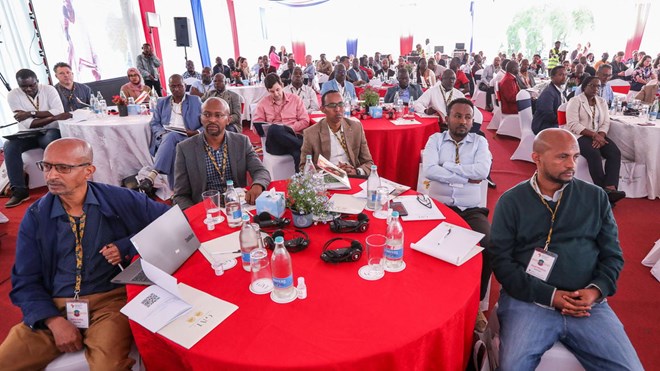
By Rachel Kibui
Thursday May 11, 2023

Participants from the Horn of Africa who met in Kenya’s Naivasha town for a conference on humanitarian development peace coherence in food crisis contexts follow proceedings on May 10, 2023. PHOTO | RACHEL KIBUI | NMG
Stakeholders from the Horn of Africa have converged in Kenya’s Naivasha town, north west of the capital Nairobi, for a four-day learning and knowledge sharing conference on humanitarian development peace (HDP) coherence in food crisis contexts.
Participants are drawn from the United States Agency for International Development (USAID) implementing partners in Kenya, Uganda, Democratic Republic of Congo (DRC), Ethiopia, South Sudan and Somalia.
The conference comes at a time when the Horn of Africa is grappling with the worst drought in four decades, affecting human beings, livestock and wildlife.
Speaking while officially opening the event, Kenya’s National Drought Management Authority (NDMA) Chief Executive Hared Hassan said the East African nation in particular is just coming out of the prolonged drought that was caused by five consecutive failed rainfall seasons.
“Our communities, especially in our arid and semi-arid areas where livestock keeping is the main economic mainstay, have suffered huge livelihood losses,” he said.
“We have lost more than 2.6 million livestock valued at about $1.8 billion. In addition, we lost more than 1,200 wildlife, with elephants being the most affected,” Lt Col (Rtd) Hassan added.Acute food insecurity
As at the onset of the long rains at the end of March this year, Lt Col Hassan noted, the number of people who were facing acute food insecurity in Kenya as a result of the drought had risen to 4.9 million, up from 2.5 million in December 2021. This, he added, is besides almost a million children under five years and over 142,000 pregnant and lactating mothers exposed to acute malnutrition.
USAID Deputy Assistant Administrator, Bureau for Resilience and Food Security Mia Beers called on partners and countries to work together towards building HDP and enhancing progress beyond development programmes.
She gave the example from Kenya where the USAID/Kenya and East Africa’s Partnership for Resilience and Economic Growth (PREG) is working to build resilience among Kenya’s vulnerable communities by concentrating joint planning and coordination in the drought-prone counties, with efforts to co-create, co-finance and co-implement annual county work plans.
Coordinate resilience
Working in nine arid and semi-arid lands (Asals) counties, the PREG programme unites multiple USAID programmes and implementing partners which work with the NDMA and county governments in Kenya to coordinate resilience and economic growth activities.
“An excellent example of HDP coherence in action comes from our ongoing work in northern Ethiopia. The Livelihoods for Resilience (L4R) Activity built resilience to shocks through livelihood interventions, women’s empowerment, financial inclusion, nutrition, climate change adaptation and market systems development, with the ultimate goal of graduating households from the productive safety net programme,” Ms Beers said.
She urged stakeholders to find practical ways to serve communities, adding that they deserve holistic programming that advocates for progress beyond programmes and that puts local voices at the centre.
As the Horn of Africa continues to face new and complex shocks, the most important thing is to work towards building resilience and coherence in bringing about portfolios for humanitarian programmes, Ms Beers added.
“One thing that is for sure is that we will face complex shocks, thus the need to think about resilience building,” said Sheila Roquitte, Deputy Mission Director, USAID Kenya and East Africa Mission.
Covid-19, wars
During the last drought, she added, it was not anticipated that the Covid-19 pandemic would strike. This, coupled with the war in Ukraine and Sudan and worsened climate change, call for strong coordination among humanitarian, development and peace actors, she said.
She added that often, the needs surpass the available resources and that factors such as climate change, migration and population growth further drive demand while resources remain low.
“We therefore cannot continue thinking the same, we have to be innovative and think differently to ensure the resources are ample and needs are well met,” she said.
Ms Beers urged relevant stakeholders to consider private sector-led approaches, working across sectors, use of government officials and regional organisations in addressing bottlenecks, and evidence-based approaches such as data-driven approaches.
The ongoing four-day high-level workshop is being held at the Great Rift Valley Lodge in the outskirts of Naivasha town and ends on Friday. It brings together over 200 delegates including high-ranking officials from USAID, USA.